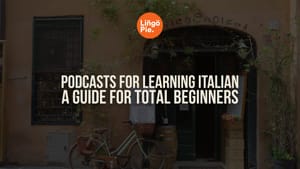Italian always shows up on "easiest languages" lists. And sure, it's a Category I language for English speakers...but that label is misleading. I've watched too many learners crash into the reality that its language difficulty ranking doesn't mean "learn in three months." The grammar has bite, the pronunciation surprises you, and actual conversation? That takes work.
So how long does it really take? I'll break down realistic timelines using CEFR levels (beginner to fluent). You'll also see the most common mistakes that tank people's progress (and how to dodge them). Plus, I'll show you how Lingopie surprisingly turns Italian TV shows and films binges into actual learning.
- Sorry In Italian: 9+ Polite Ways To Say Sorry In Italian
- 100+ Basic Italian Phrases For Travel
- How Many Italian-Speaking Countries Are Out There? [Data]

How Long Does It Take To Learn Italian?
Most people hit basic conversational fluency (enough to travel, handle everyday situations, and chat about familiar topics) in about 600 to 750 hours of focused study. That translates to 12 to 18 months if you're consistent. Study intensively (think 2-4 hours daily) and you could get there in 6 to 12 months.
Casual, sporadic practice? Expect closer to two years.
For total beginners, here's what the journey looks like broken down by CEFR levels. These timeframes assume regular, active practice—not just passively flipping through flashcards once a week.
A1 - A2 (Basic)
At the A1 stage, you can introduce yourself, order at a restaurant, ask for directions, and handle basic survival situations. Think of it as "tourist Italian"—functional, but limited.
On the other hand, A2 requires 100 to 180 hours total. By this time, you're managing simple transactions, talking about your routine, and understanding everyday conversations. You're not fluent, but you can get by in predictable scenarios without feeling completely lost.
B1 - B2 (Intermediate)
B1 needs around 240 to 360 hours. This is where things click. You can travel comfortably, handle workplace conversations, talk about your opinions, and follow the main points of TV shows or movies (even if you miss some details). Most people consider this "conversational fluency."
For B2, you'll need 320 to 620 hours. Here, you can already expect participating in detailed discussions, reading longer texts without constantly checking a dictionary, and expressing yourself with nuance. If you do speak with native speakers, you'll also notice that they'll stop simplifying their language for you.
C1 - C2 (Advanced)
C1 and C2 require 450 to 650+ hours. At this level, you're fluent enough for academic work, professional environments, and complex discussions. You understand idioms, cultural references, and can switch registers depending on context. This is where you stop translating in your head.
Key Factors Affecting Italian Learning Speed
The timelines above are estimates, not guarantees. Your actual progress depends on how you study, how often, and what you bring to the table. Some people race through A1 to B1 in under a year. Others plateau at A2 for months. The difference usually comes down to a handful of key factors.
Daily study time
Consistency beats intensity. Studying 30 minutes every day outperforms cramming three hours on Sunday. Your brain needs regular exposure to lock in vocabulary, grammar patterns, and pronunciation. Sporadic practice means constantly relearning what you've forgotten.
Active learning methods
Passive studying—flashcards, grammar drills, textbook exercises—has its place, but it won't get you fluent. You need active immersion: speaking with natives, watching Italian movies and TV shows, listening to podcasts, writing messages. The more you use Italian in real contexts, the faster your brain starts thinking in the language instead of translating.
Prior language experience
If you've learned another Romance language (Spanish, French, Portuguese), Italian will feel familiar. You already understand gendered nouns, verb conjugations, and similar vocabulary. Even experience with non-Romance languages helps—you know what language learning feels like, and that's half the battle.
Motivation and resources
Why are you learning Italian? Planning a move to Rome? Dating someone from Milan? Just love the sound? Your reason matters. People with clear goals stick with it longer. Resources matter too—access to tutors, language apps, Italian communities, or even a trip to Italy can accelerate progress in ways solo textbook study never will.
Common Mistakes With Italian
Italian might be a Category I language, but that doesn't mean learners avoid traps. Most mistakes aren't about talent or intelligence—they're about approach. Skip these common pitfalls and you'll save yourself months of frustration.
- Don't skip pronunciation from day one because sounds like gli, gn, and double consonants need attention early, or bad habits stick.
- Don't treat grammar like a checklist because memorizing conjugation tables doesn't mean you'll use them in conversation.
- Don't ignore gender when learning nouns because learning libro without il means relearning every noun later.
- Don't rely too heavily on English cognates because words like camera (room) and parenti (relatives) don't mean what they look like.
- Don't only study without speaking because you can't think your way to fluency.
- Don't skip listening to native content because real Italian sounds nothing like textbook dialogues.
Learn Italian With Lingopie
Getting to conversational fluency in 12 to 18 months isn't about finding a magic app or the perfect textbook. It's about consistent practice, active immersion, and actually using the language. That's where most learners struggle—they study hard but never make the jump from exercises to real Italian.
Lingopie fixes that!
Instead of drilling verb tables, you watch Italian TV shows and movies with interactive subtitles. Click any word for an instant definition, save it to your personalized flashcards, and hear how natives actually speak. You're learning grammar, vocabulary, and pronunciation in context the way your brain is wired to pick up language.
No more choosing between entertainment and progress. With Lingopie, binge-watching your favorite Italian shows becomes study time. Start your free trial and see how much faster you learn when Italian stops feeling like work.
FAQ
How long will it take to become fluent in Italian?
Most learners reach conversational fluency (B1-B2 level) in 12 to 18 months with consistent daily practice, which works out to about 600 to 750 hours of study. Intensive learners studying 2-4 hours daily can get there in 6 to 12 months, while casual learners might need closer to two years.
What is the hardest part of learning Italian?
Verb conjugations trip up most learners—Italian has multiple tenses, moods, and irregular verbs that take time to internalize. The gap between textbook Italian and how natives actually speak (speed, slang, regional accents) also catches people off guard.
What language is Italian similar to?
Italian is closest to Spanish, French, Portuguese, and Romanian—all Romance languages that share Latin roots. Spanish speakers often find Italian easiest because of overlapping vocabulary and similar grammar structures.
How to learn Italian language for free?
Start with free resources like YouTube channels (Learn Italian with Lucrezia, Italy Made Easy), language exchange apps (HelloTalk, Tandem), and podcasts (Coffee Break Italian). You can also try Lingopie's free trial to watch Italian shows with interactive subtitles and build vocabulary through real content.


![How Long Does It Take To Learn Italian? [2025 Guide]](/blog/content/images/size/w1200/2025/10/how-long-does-it-take-to-learn-italian.jpg)


![How Long Does It Take To Learn German? [2025 Guide]](/blog/content/images/size/w1200/2025/10/how-long-does-it-take-to-learn-german.jpg)



![10 Best Italian Shows and Movies on Netflix [For Beginners]](/blog/content/images/size/w300/2022/10/The-10-Best-Italian-Shows-and-Movies-on-Netflix-to-Learn-Italian_.webp)